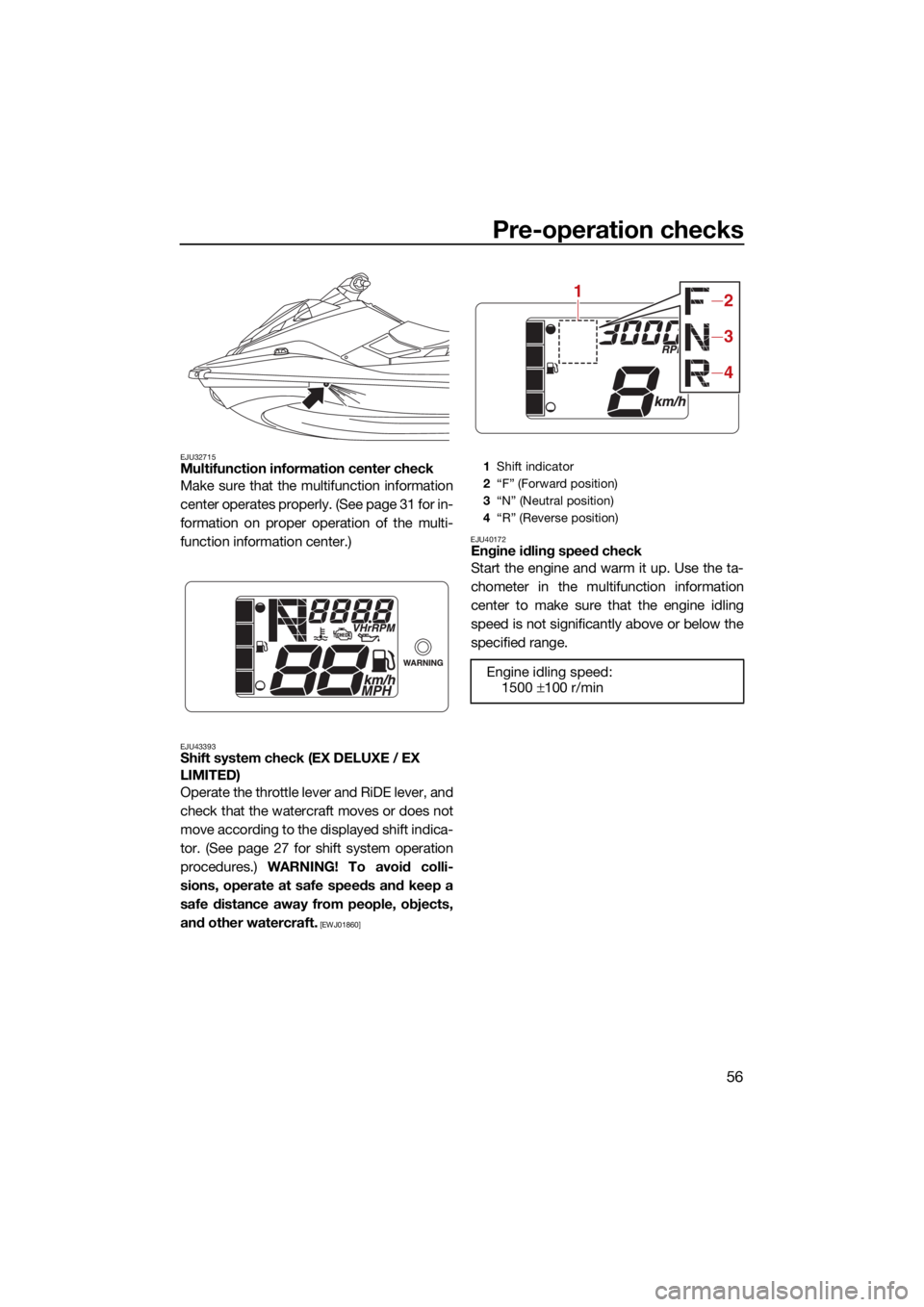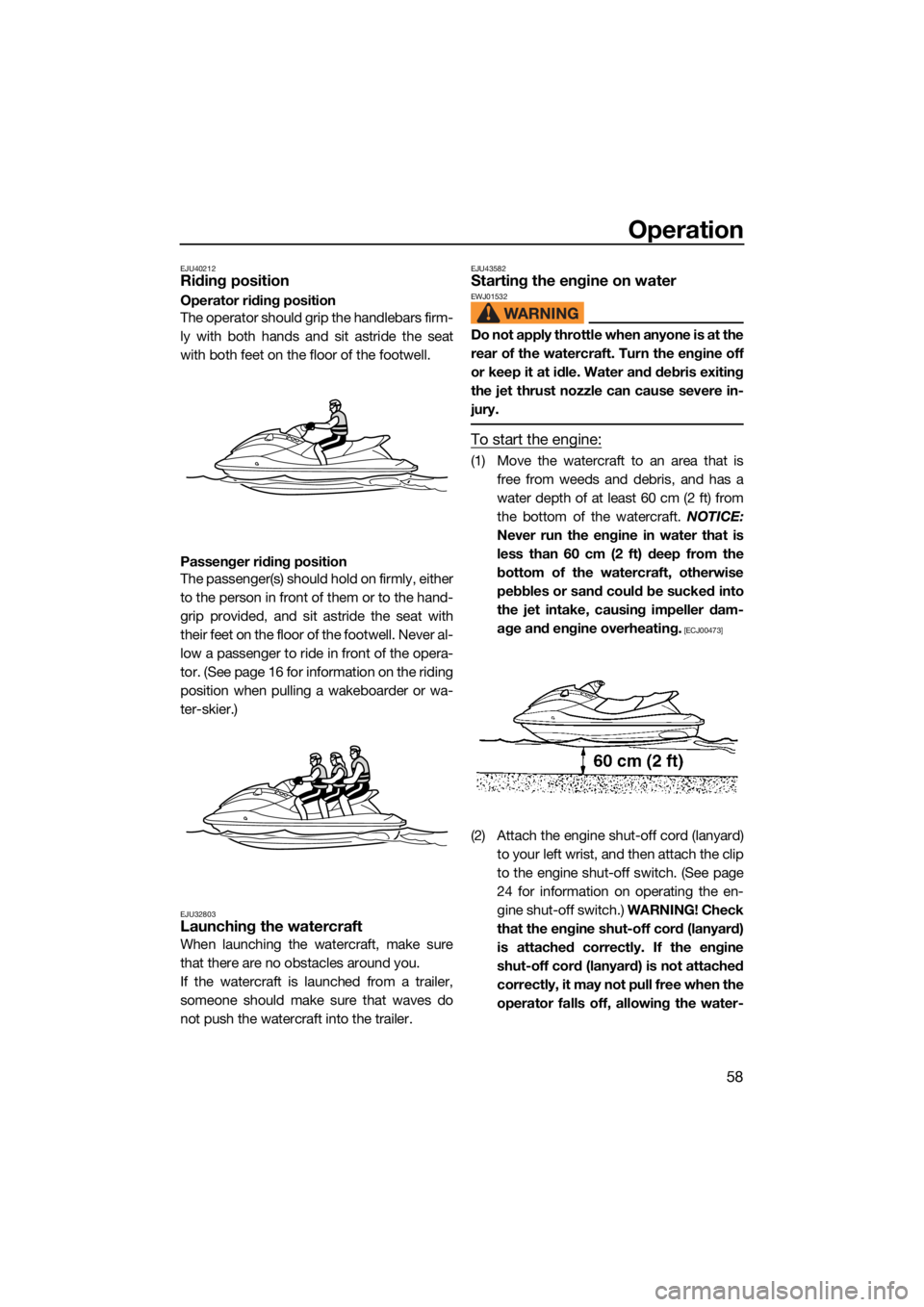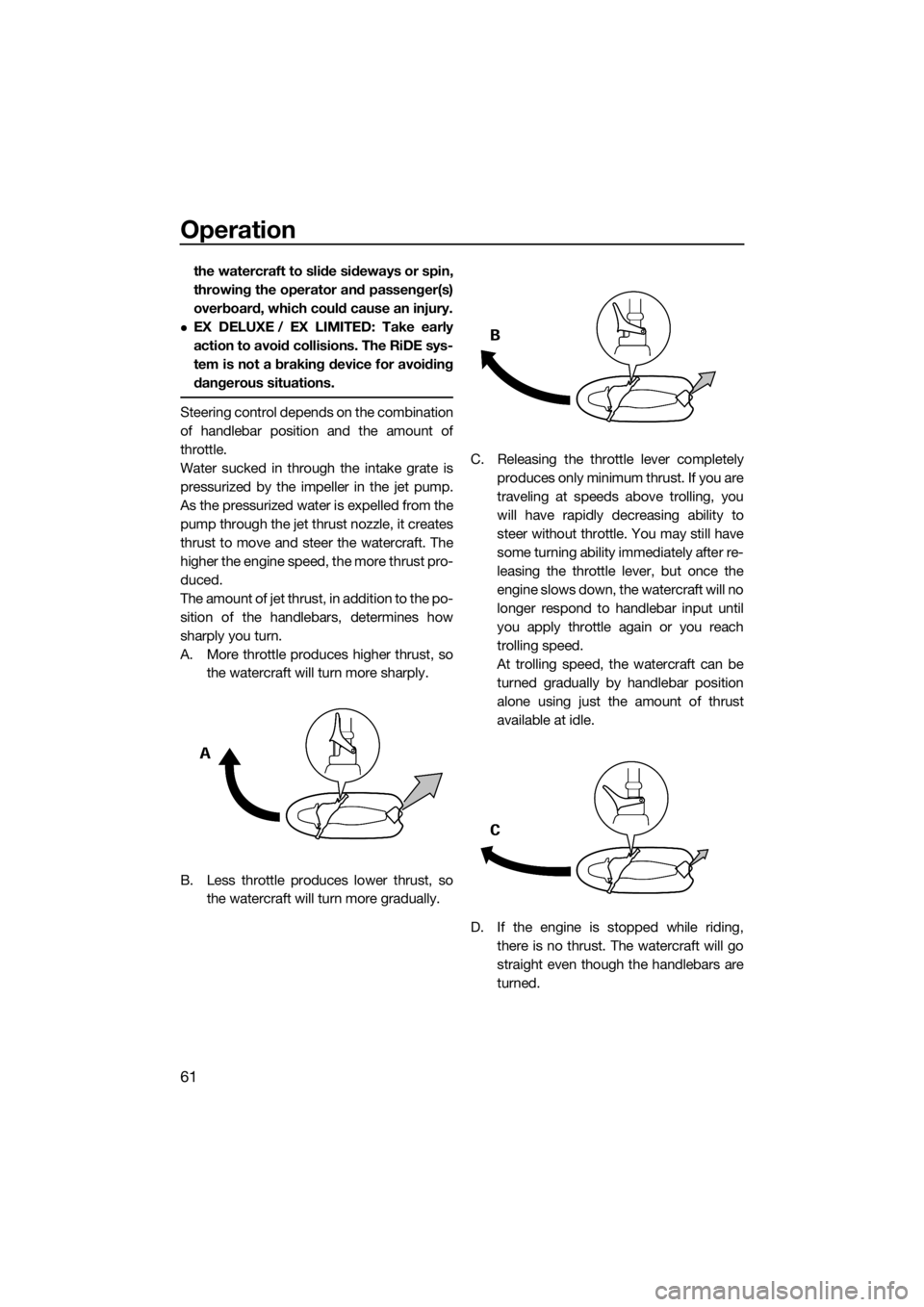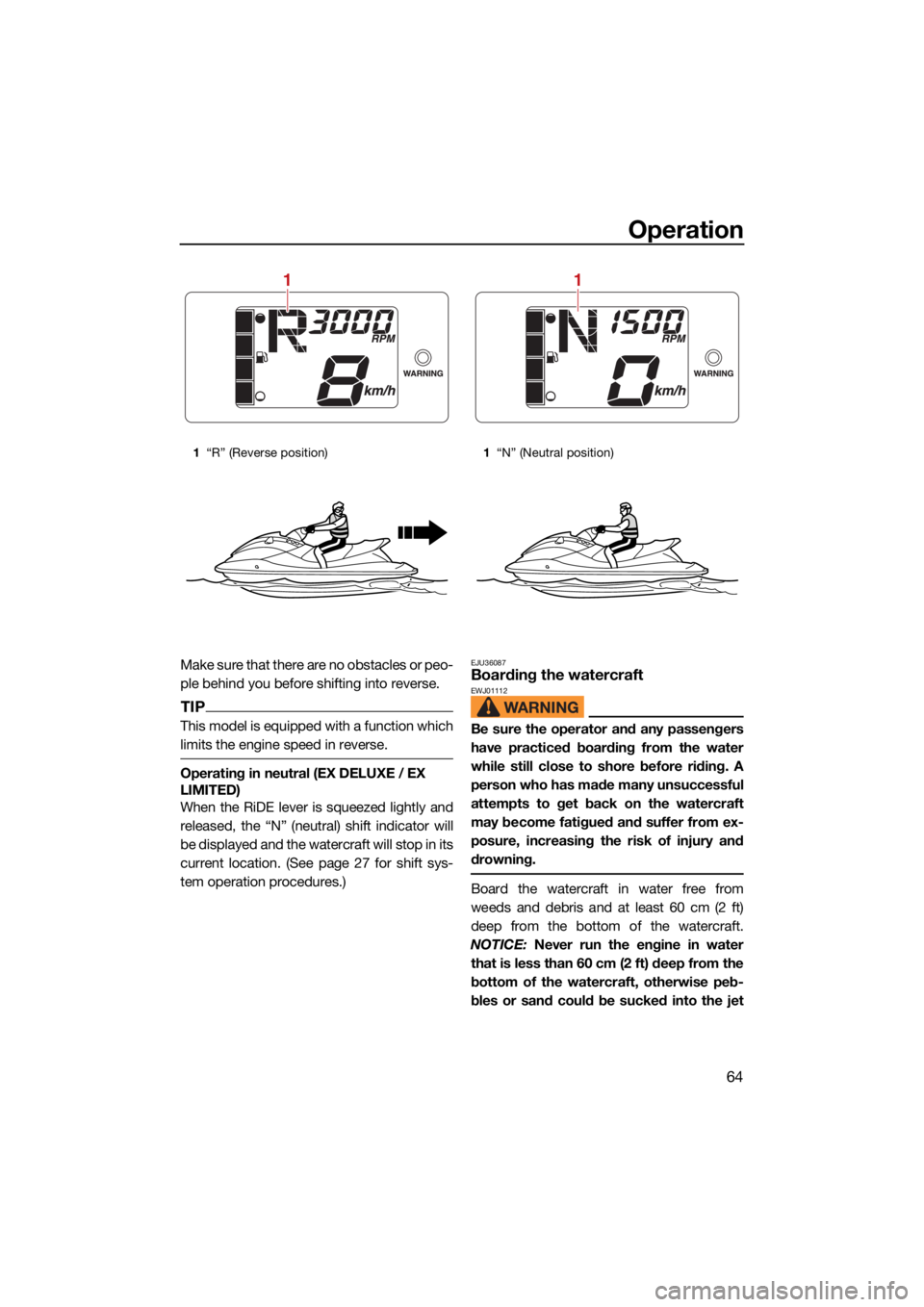engine YAMAHA EX 2022 Service Manual
[x] Cancel search | Manufacturer: YAMAHA, Model Year: 2022, Model line: EX, Model: YAMAHA EX 2022Pages: 100, PDF Size: 4.74 MB
Page 63 of 100

Pre-operation checks
56
EJU32715Multifunction information center check
Make sure that the multifunction information
center operates properly. (See page 31 for in-
formation on proper operation of the multi-
function information center.)
EJU43393Shift system check (EX DELUXE / EX
LIMITED)
Operate the throttle lever and RiDE lever, and
check that the watercraft moves or does not
move according to the displayed shift indica-
tor. (See page 27 for shift system operation
procedures.) WARNING! To avoid colli-
sions, operate at safe speeds and keep a
safe distance away from people, objects,
and other watercraft.
[EWJ01860] EJU40172
Engine idling speed check
Start the engine and warm it up. Use the ta-
chometer in the multifunction information
center to make sure that the engine idling
speed is not significantly above or below the
specified range.
1
Shift indicator
2 “F” (Forward position)
3 “N” (Neutral position)
4 “R” (Reverse position)
Engine idling speed:
1500 ±100 r/min
12
3
4
UF3Y75E0.book Page 56 Tuesday, July 27, 2021 2:27 PM
Page 65 of 100

Operation
58
EJU40212Riding position
Operator riding position
The operator should grip the handlebars firm-
ly with both hands and sit astride the seat
with both feet on the floor of the footwell.
Passenger riding position
The passenger(s) should hold on firmly, either
to the person in front of them or to the hand-
grip provided, and sit astride the seat with
their feet on the floor of the footwell. Never al-
low a passenger to ride in front of the opera-
tor. (See page 16 for information on the riding
position when pulling a wakeboarder or wa-
ter-skier.)
EJU32803Launching the watercraft
When launching the watercraft, make sure
that there are no obstacles around you.
If the watercraft is launched from a trailer,
someone should make sure that waves do
not push the watercraft into the trailer.
EJU43582Starting the engine on waterEWJ01532
Do not apply throttle when anyone is at the
rear of the watercraft. Turn the engine off
or keep it at idle. Water and debris exiting
the jet thrust nozzle can cause severe in-
jury.
To start the engine:
(1) Move the watercraft to an area that isfree from weeds and debris, and has a
water depth of at least 60 cm (2 ft) from
the bottom of the watercraft. NOTICE:
Never run the engine in water that is
less than 60 cm (2 ft) deep from the
bottom of the watercraft, otherwise
pebbles or sand could be sucked into
the jet intake, causing impeller dam-
age and engine overheating.
[ECJ00473]
(2) Attach the engine shut-off cord (lanyard) to your left wrist, and then attach the clip
to the engine shut-off switch. (See page
24 for information on operating the en-
gine shut-off switch.) WARNING! Check
that the engine shut-off cord (lanyard)
is attached correctly. If the engine
shut-off cord (lanyard) is not attached
correctly, it may not pull free when the
operator falls off, allowing the water-
UF3Y75E0.book Page 58 Tuesday, July 27, 2021 2:27 PM
Page 66 of 100
![YAMAHA EX 2022 Service Manual Operation
59
craft to continue to run and cause an
accident.
[EWJ00583]
(3) With the throttle lever released, push thestart switch (green button) to start the
engine. (See page 24 for information on
YAMAHA EX 2022 Service Manual Operation
59
craft to continue to run and cause an
accident.
[EWJ00583]
(3) With the throttle lever released, push thestart switch (green button) to start the
engine. (See page 24 for information on](/img/51/49467/w960_49467-65.png)
Operation
59
craft to continue to run and cause an
accident.
[EWJ00583]
(3) With the throttle lever released, push thestart switch (green button) to start the
engine. (See page 24 for information on
operating the start switch.)
EJU32863Stopping the engine
Release the throttle lever, and then push the
engine stop switch (red button) to stop the
engine. WARNING! You need throttle to
steer. Shutting the engine off can cause
you to hit an obstacle you are attempting
to avoid. A collision could result in severe
injury or death.
[EWJ00602] EJU32874
Leaving the watercraft
If leaving the watercraft, remove the clip from
the engine shut-off switch to prevent acci-
dental starting or unauthorized operation by
children or others.
EJU44361Operating the watercraft
EX:
When the engine is running, the watercraft
will move forward at trolling speed even if the
throttle lever is in the fully closed (idle) posi-
tion.
1
Clip
2 Engine shut-off switch
3 Engine shut-off cord (lanyard)
12
3
UF3Y75E0.book Page 59 Tuesday, July 27, 2021 2:27 PM
Page 67 of 100

Operation
60
EX SPORT:
When the shift lever is in the forward position
and the engine is running, the watercraft will
move forward. The watercraft will move for-
ward at trolling speed even if the throttle lever
is in the fully closed (idle) position. (See page
27 for information on operating the shift le-
ver.)EX DELUXE / EX LIMITED:
When the throttle lever is squeezed, the “F”
(forward) shift indicator will be displayed and
the watercraft will move forward. While the
“F” (forward) shift indicator is displayed, the
watercraft will move forward at trolling speed
even if the throttle lever is in the fully closed
(idle) position. (See page 27 for shift system
operation procedures.)
EJU43423Turning the watercraftEWJ01783
Do not release the throttle lever when
trying to steer away from objects—as
with other powerboats, you need throt-
tle to steer. A collision could result in se-
vere injury or death.
When operating at higher speeds, make
gradual turns or slow down before turn-
ing. Sharp high-speed turns may cause
1
Shift lever
2 Forward position
1
2
1“F” (Forward position)
1
UF3Y75E0.book Page 60 Tuesday, July 27, 2021 2:27 PM
Page 68 of 100

Operation
61
the watercraft to slide sideways or spin,
throwing the operator and passenger(s)
overboard, which could cause an injury.
EX DELUXE / EX LIMITED: Take early
action to avoid collisions. The RiDE sys-
tem is not a braking device for avoiding
dangerous situations.
Steering control depends on the combination
of handlebar position and the amount of
throttle.
Water sucked in through the intake grate is
pressurized by the impeller in the jet pump.
As the pressurized water is expelled from the
pump through the jet thrust nozzle, it creates
thrust to move and steer the watercraft. The
higher the engine speed, the more thrust pro-
duced.
The amount of jet thrust, in addition to the po-
sition of the handlebars, determines how
sharply you turn.
A. More throttle produces higher thrust, sothe watercraft will turn more sharply.
B. Less throttle produces lower thrust, so the watercraft will turn more gradually. C. Releasing the throttle lever completely
produces only minimum thrust. If you are
traveling at speeds above trolling, you
will have rapidly decreasing ability to
steer without throttle. You may still have
some turning ability immediately after re-
leasing the throttle lever, but once the
engine slows down, the watercraft will no
longer respond to handlebar input until
you apply throttle again or you reach
trolling speed.
At trolling speed, the watercraft can be
turned gradually by handlebar position
alone using just the amount of thrust
available at idle.
D. If the engine is stopped while riding, there is no thrust. The watercraft will go
straight even though the handlebars are
turned.
UF3Y75E0.book Page 61 Tuesday, July 27, 2021 2:27 PM
Page 69 of 100

Operation
62
You need throttle to steer.
E. EX DELUXE / EX LIMITED: If the RiDE le- ver is squeezed and the handlebars are
turned when the watercraft is cruising at
planing speed, the watercraft will turn
gradually while slowing down.
This model is equipped with the Yamaha En-
gine Management System (YEMS) that in-
cludes an off-throttle steering (OTS) system.
It will activate at planing speeds should you
attempt to steer the watercraft after releasing
the throttle lever (see condition C above).
The OTS system assists in turning by con-
tinuing to supply some thrust while the water-
craft is decelerating, but you can turn more
sharply if you apply throttle while turning the
handlebars. The OTS system does not func-
tion below planing speeds or when the en-
gine is off. Once the engine slows down, the watercraft will no longer turn in response to
handlebar input until you apply throttle again
or you reach trolling speed.
EJU44371Stopping the watercraft
The watercraft is not equipped with a sepa-
rate braking system. The watercraft slows
down by water resistance or, when operating
in reverse, by the water jet. The watercraft
slows down as soon as the throttle lever is re-
leased, but will coast for a distance before
fully stopping. If you are not sure you can
stop in time before hitting an obstacle, apply
throttle and turn in another direction.
From full speed, the watercraft comes to a
complete stop due to water resistance in ap-
proximately 90 m (300 ft) after the throttle le-
ver is released or the engine is stopped,
although this distance will vary depending on
many factors, including gross weight, water
surface conditions, and wind direction.
EX DELUXE / EX LIMITED: If the RiDE lever is
squeezed to slow down, the stopping dis-
tance is approximately 30% shorter than
when the RiDE lever is not used. However,
this distance will vary depending on many
factors, including gross weight, water surface
conditions, and wind direction.
1
Reverse gate
E
190 m (300 ft)
UF3Y75E0.book Page 62 Tuesday, July 27, 2021 2:27 PM
Page 70 of 100

Operation
63
EWJ01971
Allow adequate stopping distance. Stay
far enough away from others so you can
always safely coast to a stop.
Take early action to avoid collisions. Re-
member, watercraft and other boats do
not have brakes.
Operate defensively at safe speeds and
keep a safe distance away from people,
objects, and other watercraft to give you
time to stop.
Do not shut the engine off when slowing
down in case you need engine power to
steer away from a boat or other obstacle
that comes into your path.
EX SPORT: Do not use the reverse func-
tion to slow down or stop the watercraft
as it could cause you to lose control, be
ejected, or impact the handlebars.
EX DELUXE / EX LIMITED: To avoid
rear-end collisions while operating the
watercraft, check behind you before us-
ing the RiDE lever to slow down or stop
the watercraft.
EJU44682Operating the watercraft in reverse or
neutral (EX SPORT / EX DELUXE / EX
LIMITED)
Operating in reverse (EX SPORT)
Pull the shift lever rearward to the reverse po-
sition. The watercraft will move in reverse.
(See page 27 for information on the reverse
system.) Make sure that there are no obstacles or peo-
ple behind you before shifting into reverse.
TIP
This model is not equipped with a neutral
function.
Operating in reverse (EX DELUXE / EX
LIMITED) When the RiDE lever is squeezed, the “R” (re-
verse) shift indicator will be displayed and the
watercraft will move in reverse. (See page 27
for shift system operation procedures.)
1 Shift lever
2 Reverse position
1
2
UF3Y75E0.book Page 63 Tuesday, July 27, 2021 2:27 PM
Page 71 of 100

Operation
64
Make sure that there are no obstacles or peo-
ple behind you before shifting into reverse.
TIP
This model is equipped with a function which
limits the engine speed in reverse.
Operating in neutral (EX DELUXE / EX
LIMITED)
When the RiDE lever is squeezed lightly and
released, the “N” (neutral) shift indicator will
be displayed and the watercraft will stop in its
current location. (See page 27 for shift sys-
tem operation procedures.)
EJU36087Boarding the watercraftEWJ01112
Be sure the operator and any passengers
have practiced boarding from the water
while still close to shore before riding. A
person who has made many unsuccessful
attempts to get back on the watercraft
may become fatigued and suffer from ex-
posure, increasing the risk of injury and
drowning.
Board the watercraft in water free from
weeds and debris and at least 60 cm (2 ft)
deep from the bottom of the watercraft.
NOTICE: Never run the engine in water
that is less than 60 cm (2 ft) deep from the
bottom of the watercraft, otherwise peb-
bles or sand could be sucked into the jet
1 “R” (Reverse position)
1
1“N” (Neutral position)
1
UF3Y75E0.book Page 64 Tuesday, July 27, 2021 2:27 PM
Page 72 of 100
![YAMAHA EX 2022 Service Manual Operation
65
intake, causing impeller damage and en-
gine overheating.
[ECJ00473]
TIP
EX SPORT / EX DELUXE / EX LIMITED: This
watercraft is equipped with a reboarding
step, which can be lowered and u YAMAHA EX 2022 Service Manual Operation
65
intake, causing impeller damage and en-
gine overheating.
[ECJ00473]
TIP
EX SPORT / EX DELUXE / EX LIMITED: This
watercraft is equipped with a reboarding
step, which can be lowered and u](/img/51/49467/w960_49467-71.png)
Operation
65
intake, causing impeller damage and en-
gine overheating.
[ECJ00473]
TIP
EX SPORT / EX DELUXE / EX LIMITED: This
watercraft is equipped with a reboarding
step, which can be lowered and used to as-
sist in reboarding. (See page 37 for informa-
tion on operating the reboarding step.)
EJU36354Boarding alone
(1) From the rear of the watercraft, placeboth hands on the boarding platform,
pull yourself up, and then grasp the
handgrip with one hand.
(2) Pull yourself up to a kneeling position on the boarding platform, and then move to
the seat and sit astride. (3) Attach the engine shut-off cord (lanyard)
to your left wrist, and then attach the clip
to the engine shut-off switch.
(4) Grip the handlebars with both hands and place both feet on the floor of the foot-
well.
(5) Look in all directions, start the engine, and then start off slowly.
EJU43260Boarding with passenger(s)EWJ01800
Severe internal injuries can occur if wa-
ter is forced into body cavities as a re-
sult of being near the jet thrust nozzle.
Do not start the engine until the passen-
gers are seated with their feet on the
floor of the footwell and are securely
holding on to the person in front of them
or to the handgrip provided.
Before boarding the watercraft, make
sure that the engine is stopped. If the
60 cm (2 ft)
UF3Y75E0.book Page 65 Tuesday, July 27, 2021 2:27 PM
Page 73 of 100

Operation
66
engine is running, the reverse gate may
move down and a person boarding
could be pinched.
The heavier the total weight of the operator
and passenger(s), the more difficult it will be
to balance the watercraft. Do not operate the
watercraft when the total weight exceeds 225
kg (496 lb) including any cargo.
To board with passenger(s):
(1) Board as noted in the previous section“Boarding alone”.
(2) Grip the handlebars with both hands and place both feet on the floor of the foot-
well.
(3) Have the first passenger move to the rear of the watercraft.
(4) Have the first passenger board using the same procedure as the operator, place
their feet on the floor of the footwell, and
securely hold on to the operator. (5) Have the second passenger follow the
same procedure. When the second pas-
senger is boarding, try to balance the
watercraft together with the first passen-
ger.
(6) Make sure that the passenger(s) have their feet on the floor of the footwell and
are securely holding on to the person in
front of them or to the handgrip provided.
UF3Y75E0.book Page 66 Tuesday, July 27, 2021 2:27 PM